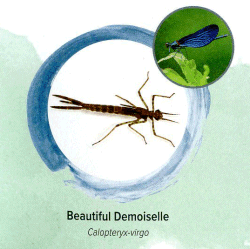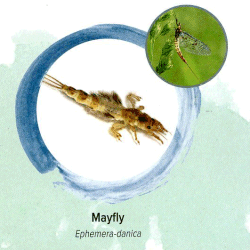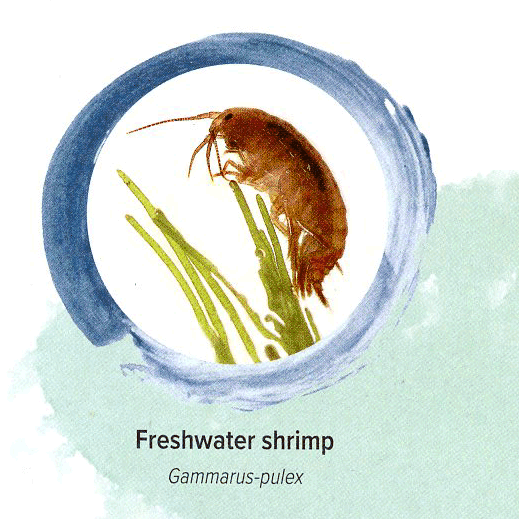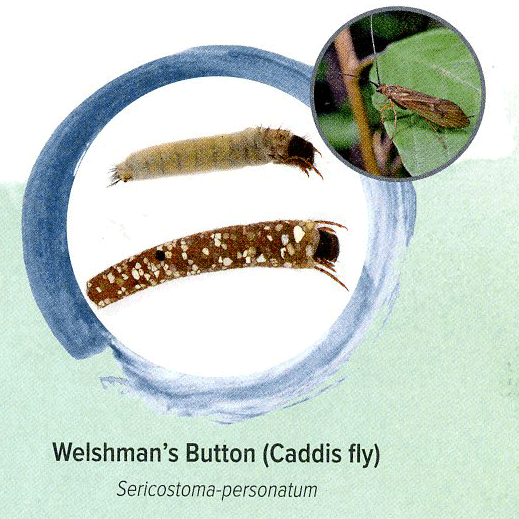
The Alresford Eel House
History and Habitat
The chalk stream invertebrates
As the water which becomes the River Alre passes through the aquifer, this adds minerals and filters out impurities. It also cools the water, so the river emerges from the springs at about 10°C whatever the weather. This cool, clear water, running through a gravelly bed provides an ideal habitat for many kinds of life, including fish and eels.
In particular, it supports vast colonies of invertebrates – creatures without a backbone – such as molluscs (snails and limpets), crustaceans (shrimps and slaters), insects (flies, beetles & bugs), leeches, worms and flatworms. Many turn into flies - mayflies, dragon flies, damsel flies, midges and gnats. Some - snails, shrimps and beetles - spend their life in the water. They are all crucial parts of the ‘food chain’ which supports the fish and eels in the river, which in turn support creatures such as otters, kingfishers, bats, herons, egrets.
Invertebrates are very sensitive to pollution, and without them the whole eco-system declines rapidly. A decline in the invertebrate population heralds a decline in the eco-system they support.
To show the variety of life in the river, visitors to the Eel House can look at a sample of creatures, mainly invertebrates, which have been taken out of the river, before being put back later in the day. Four species you are likely to see:
Beautiful Demoiselle
 The beautiful demoiselle may look like a dragonfly, but it is in fact a large damselfly. The males are metallic blue and the females green. They live in and around small, fast flowing rivers in the west of the UK, often to be seen in summer months ‘dancing’ around the bankside vegetation. They spend most of their life (normally 2-3 years) underwater as a nymph (seen here on the left), shedding their skin several times (moulting), until they climb up bankside vegetation to finally hatch into the winged adult, which lives for about 2 months, before mating, laying its eggs and dying, to begin the life cycle all over again.
The beautiful demoiselle may look like a dragonfly, but it is in fact a large damselfly. The males are metallic blue and the females green. They live in and around small, fast flowing rivers in the west of the UK, often to be seen in summer months ‘dancing’ around the bankside vegetation. They spend most of their life (normally 2-3 years) underwater as a nymph (seen here on the left), shedding their skin several times (moulting), until they climb up bankside vegetation to finally hatch into the winged adult, which lives for about 2 months, before mating, laying its eggs and dying, to begin the life cycle all over again.
Mayfly (ephemera danica)
 This is just one of a whole family of mayflies, with this particular one (ephemera danica) very common along the River Itchen and its tributaries. It spends 1-2 years as a nymph, growing to about 3cm long before rising to the surface, hatching out in the surface film of the water and flying off; during this hatching process it is highly vulnerable to predatory fish such as brown trout. Mayflies hatch typically in May (surprise, surprise), although they can be seen a couple of weeks either side of that. They then spend just 24-48 hours mating and laying eggs on the surface of the water before dying and providing a meal for many fish and birds. During mating time, it is not unusual to see ‘clouds’ of mayfly dancing in the trees and bushes alongside the river. Mayflies are harmless and do not bite, so if one lands on you whilst you’re walking alongside the river, take time to study and marvel at this exquisite and delicate creature. Mayflies provide a good ‘barometer’ of a river’s health, as they are very sensitive to organic pollution.
This is just one of a whole family of mayflies, with this particular one (ephemera danica) very common along the River Itchen and its tributaries. It spends 1-2 years as a nymph, growing to about 3cm long before rising to the surface, hatching out in the surface film of the water and flying off; during this hatching process it is highly vulnerable to predatory fish such as brown trout. Mayflies hatch typically in May (surprise, surprise), although they can be seen a couple of weeks either side of that. They then spend just 24-48 hours mating and laying eggs on the surface of the water before dying and providing a meal for many fish and birds. During mating time, it is not unusual to see ‘clouds’ of mayfly dancing in the trees and bushes alongside the river. Mayflies are harmless and do not bite, so if one lands on you whilst you’re walking alongside the river, take time to study and marvel at this exquisite and delicate creature. Mayflies provide a good ‘barometer’ of a river’s health, as they are very sensitive to organic pollution.
Gammarus (freshwater shrimp)
 The freshwater shrimp spends the whole of its life in the river, usually living 1-2 years. The female produces 6-10 'broods' of young in summer, with the males grow 1-2 cms longer. They are omnivores and live off microscopic algae as well as bloodworms. These shrimps are typically very prolific in chalk streams, where they can occur in huge numbers and form part of the staple diet of fish such as brown trout: they are an important part of the food chain.
The freshwater shrimp spends the whole of its life in the river, usually living 1-2 years. The female produces 6-10 'broods' of young in summer, with the males grow 1-2 cms longer. They are omnivores and live off microscopic algae as well as bloodworms. These shrimps are typically very prolific in chalk streams, where they can occur in huge numbers and form part of the staple diet of fish such as brown trout: they are an important part of the food chain.
Cased Caddis fly (Welshman's Button):
 Caddis flies (both cased and uncased) come in many varieties, and there are huge numbers of them in Hampshire chalk streams: a rich source of food for fish. The cased caddis (like the one on the left) build themselves a small protective case out of a wide variety of materials (in this case tiny grains of sand) which are glued together with silk that they produce. They continually add to their case as they grow, before pupating after 12 months in the river and emerging from the water as an adult sedge fly, where they live for a few weeks in order to mate and lay their eggs.
Caddis flies (both cased and uncased) come in many varieties, and there are huge numbers of them in Hampshire chalk streams: a rich source of food for fish. The cased caddis (like the one on the left) build themselves a small protective case out of a wide variety of materials (in this case tiny grains of sand) which are glued together with silk that they produce. They continually add to their case as they grow, before pupating after 12 months in the river and emerging from the water as an adult sedge fly, where they live for a few weeks in order to mate and lay their eggs.
These fascinating creatures, at the start of the food chain, are especially vulnerable to water pollution: run-off from fertilisers on farm land and private homes not connected to the mains, while excessive water abstraction concentrates such pollutants. As a result, wildlife has declined for many years. Improving the status of these chalk streams and their inhabitants is the subject of the Hampshire & Isle of Wight Wildlife Trust project 'Watercress & Winterbournes' where you can learn more about how you can help improve the chalk streams such as the River Alre.